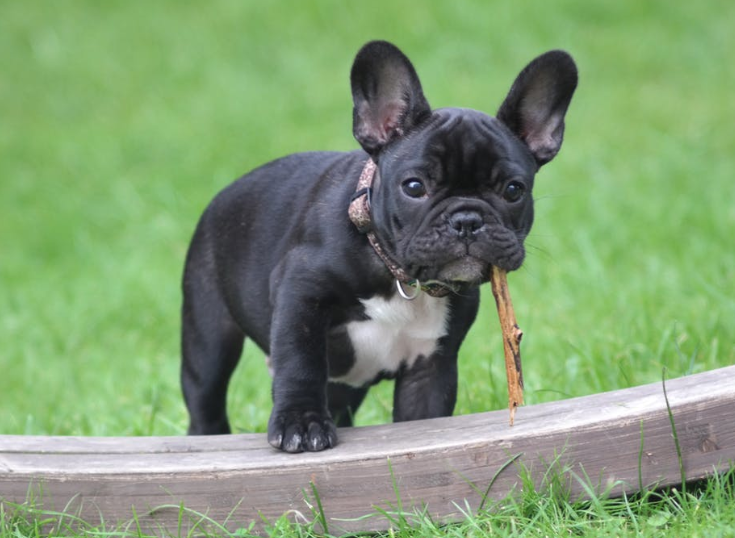The origin of the modern French Bulldog breed descends directly from the dogs of the Molossians, an ancient Greek tribe. The dogs were spread throughout the ancient world by Phoenician traders.
British Molossian dogs were developed into the Mastiff. A sub-family of the Mastiff were the Bullenbeisser, a type of dog used for bull-baiting. Blood sports such as bull-baiting were outlawed in England in 1835, leaving these “Bulldogs” unemployed. However, they had been bred for non-sporting reasons since at least 1800, and so their use changed from a sporting breed to a companion breed.
To reduce their size, some Bulldogs were crossed with terriers, while others were crossed with pugs. By 1850 the Toy Bulldog had become common in England, and appeared in conformation shows when they began around 1860.These dogs weighed around 16–25 pounds (7.3–11.3 kg), although classes were also available at dog shows for those that weighed under 12 pounds (5.4 kg). At the same time, lace workers from Nottingham, displaced by the Industrial Revolution, began to settle in Normandy, France. They brought a variety of dogs with them, including Miniature Bulldogs. The dogs became popular in France and a trade in imported small Bulldogs was created, with breeders in England sending over Bulldogs that they considered to be too small, or with faults such as ears that stood up.
By 1860, there were few Miniature Bulldogs left in England, such was their popularity in France and due to the exploits of specialist dog exporters. The small Bulldog type gradually became thought of as a breed, and received a name, the Bouledogue Francais. This Francization of the English name is also a contraction of the words boule (ball) and dogue (mastiff or molosser). The dogs were highly fashionable and were sought after by society ladies and Parisian prostitutes alike, as well as creatives such as artists, writers, and fashion designers. However, records were not kept of the breed’s development as it diverged further away from its original Bulldog roots. As it changed, terrier and pug stock may have been brought in to develop traits such as the breed’s long straight ears, and the roundness of their eyes.
The French Bulldog, like many other companion dog breeds, requires close contact with humans. As a result, they should not be left alone for more than a few hours because these dogs experience separation anxiety if they are alone for too long. This is especially important when French Bulldogs are young, but this issue remains a concern into adulthood. Being alone for too long can cause a French Bulldog to behave in a destructive manner, which can include chewing on household items or furniture or even going to the bathroom in the house. They have fairly minimal exercise needs, but do require at least daily short walks.
The French Bulldog is sometimes called “Frog dog” or a “Clown dog”. “Frog dog” is in reference to their wide round face and the unique way they sit with hind legs spread out. “Clown dog” is because they are known to be fun loving vivacious “clowns of the dog world”.Their calm nature makes them an excellent choice for apartment dwellers, as does their sensible attitude towards barking. Their bulk and their compromised breathing system makes it impossible for them to regulate their temperature efficiently.
The French bulldog has only a single short coat. This means the dog may easily become cold. Also, they will very likely need to have some extra covering inside during the winter in particularly cold areas. These dogs need warm clothing when out in cold weather. Precautions must be taken when exercising during hot or humid weather, as they are prone to heat stroke. It is also recommended that French Bulldogs who live indoors have access to air conditioning to regulate their temperature. In terms of grooming, the French Bulldog requires regular nail trimming, brushing, occasional bathing, and ear cleaning. French Bulldogs make excellent companions.
The French Bulldog rarely barks, and if he does it is to draw attention, to point out that he needs something (like attention). This breed is patient and affectionate with its owners, especially with children, who are especially protected by the females. French Bulldogs can easily live with other breeds when the proper introductions are done. They are ranked 58th in Stanley Coren’s The Intelligence of Dogs. There are certain exceptions to this average level of canine intelligence; a French Bulldog named Princess Jacqueline which died in 1934 was claimed to understand 20 words, reacting correctly.


